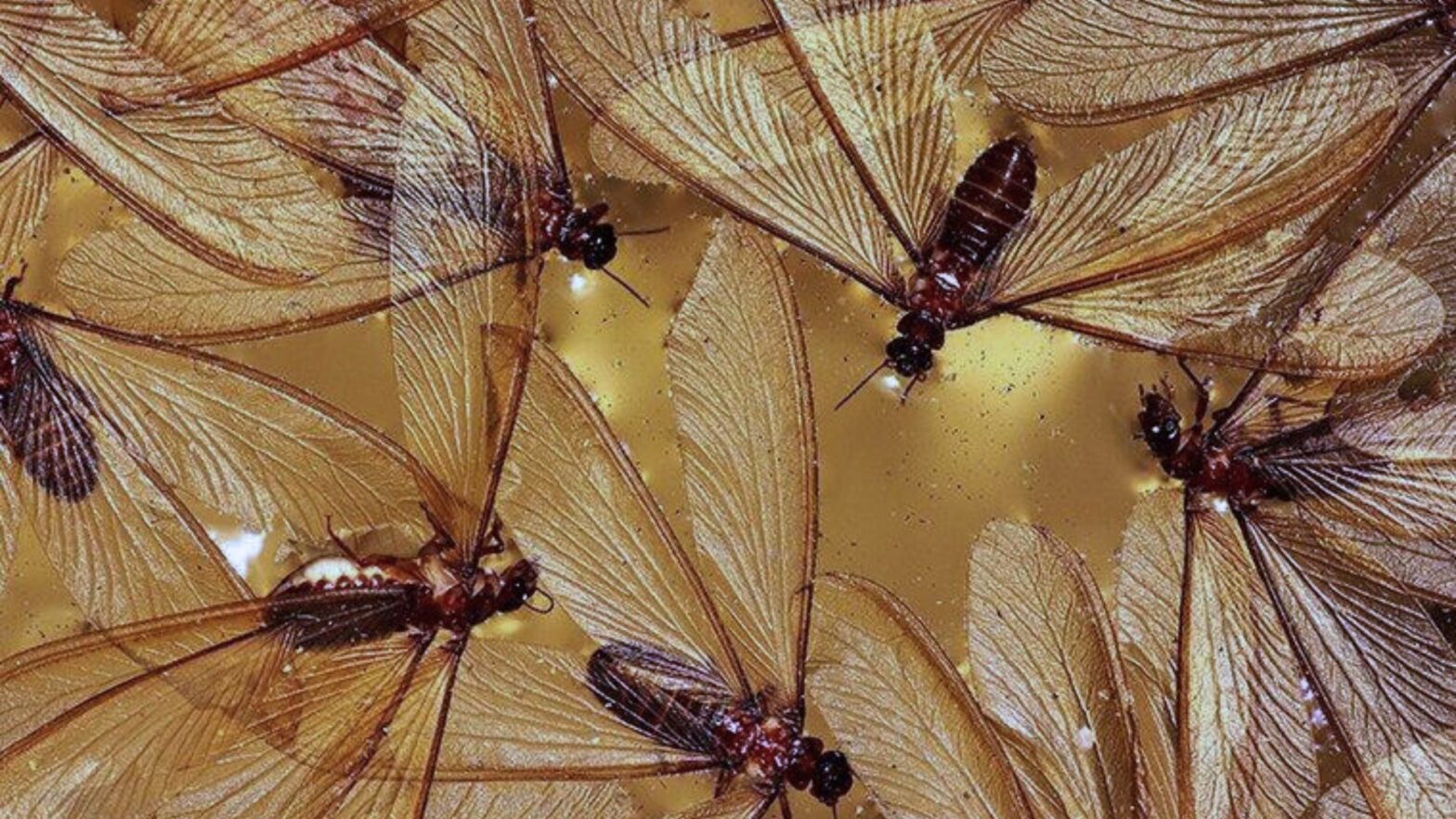When most people think of termites, they picture pale, soft-bodied insects silently destroying wood. But spotting black termites often raises alarm—and for good reason. These dark-colored bugs may seem different, but they’re often just another form of the same destructive pest. Whether you’re dealing with a swarm or seeing wings by your windowsill, knowing what you’re looking at is the first step to protecting your home.
In this article, we’ll break down what black termites really are, how to tell them apart from other pests, and what you can do to stop them before they cause serious damage.
What are Black Termites
Black termites are not a separate species of termite. Instead, this term is commonly used to describe termite swarmers, also known as alates. These termites are the reproductive members of a mature colony. When conditions are right, typically in the spring or after rain, they leave the nest in large groups to mate and form new colonies. During this swarming phase, they develop dark, almost black bodies, which helps protect them from sunlight and makes them more resilient as they search for a new nesting site.
These black-bodied swarmers are often the only termites you’ll ever actually see out in the open. The worker and soldier termites, which make up the majority of the colony, remain hidden in walls, soil, or wood. Seeing black termites can be alarming because it usually means there’s an established colony nearby, and possibly inside your home. Even if you only spot a few, it’s worth investigating. A swarm means the colony is mature enough to expand, which puts your property at greater risk.
Black Termites vs Carpenter Ants

Black termites are easy to confuse with carpenter ants. Both swarm during the warmer months, and both are dark in color with wings. However, there are key differences that can help you tell them apart.
-
Antennae: Black termites have straight, beaded antennae, while carpenter ants have elbowed or bent antennae.
-
Waist: Black termites have a thick, uniform waist, while carpenter ants have a narrow, pinched waist.
-
Wings: Black termites have two pairs of wings that are equal in length and extend well past their bodies. Carpenter ants have uneven wings, with the front pair longer than the back.
-
Behavior: Black termites often shed their wings shortly after swarming. If you find piles of wings near windows, that’s a strong sign of termites.
Misidentifying these pests can lead to wasted time and money on the wrong treatment. If you’re unsure, it’s best to let a professional pest control technician identify the pest and recommend the proper course of action.
Why You Might See Black Termites Indoors
Spotting black termites inside your home can be unsettling. While you might think they accidentally wandered in from the outside, their presence indoors usually points to a more serious issue. When termites swarm, they’re looking for a new place to settle and reproduce. If they’re emerging from your walls, ceiling, or floorboards, that means they’ve already been living inside your home for some time. It also means the original colony is likely large and well-established.
Another reason black termites may appear inside is light. Swarmers are highly attracted to light sources and are often found near windows, light fixtures, or screens. This is why homeowners commonly notice them on sunny days or near lamps in the evening. They may enter through gaps or cracks in your foundation, vents, or even plumbing access points.
Even if they haven’t nested inside your home yet, seeing them inside suggests they’re close. Black termites don’t travel far from their colonies. If they’re swarming in your kitchen or bathroom, there’s a high chance the colony is within or just beneath your property. Early action is critical to avoid costly repairs and more extensive damage down the road.
Damage Caused by Black Termites
Black termites are just as destructive as their lighter-colored counterparts. Once the swarmers land and shed their wings, they find a mate and begin forming a new colony. The real damage happens over time, when thousands of termites start eating away at your home from the inside out. Unfortunately, termite damage is often hidden until it becomes severe.
These pests feed on cellulose, a material found in wood and other plant-based building materials. As they consume the wood in your home, they weaken the structural integrity of beams, joists, floors, and walls. This damage doesn’t happen overnight, but over months or years, it can compromise your entire structure.
In some cases, homeowners only realize there’s a problem when doors begin sticking, floors start sagging, or baseboards crumble to the touch. Termites can also damage drywall, insulation, wooden furniture, and even books or cardboard boxes.
According to the National Pest Management Association, termites cause over $5 billion in property damage annually across the United States. That’s more than fires, storms, and earthquakes combined. Insurance policies usually don’t cover this kind of damage, which makes early detection and prevention even more important.

Signs of a Black Termite Infestation
Spotting black termites is one clue, but other signs can help confirm an active infestation. Keep your eyes out for the following:
-
Discarded wings near windows, doors, or light fixtures.
-
Mud tubes on walls, in crawlspaces, or along your foundation.
-
Bubbling or peeling paint that resembles water damage.
-
Wood that sounds hollow when tapped.
-
Cracked or distorted wood surfaces.
-
Termite droppings (frass), which look like tiny wood-colored pellets.
These indicators often go unnoticed, especially in areas of the home that aren’t used frequently. Regular inspections by a pest control professional are the best way to catch problems early and keep your home protected year-round.
How to Prevent Black Termites
Preventing black termites starts with limiting their access to the three things they love most—moisture, wood, and shelter. With a few smart home maintenance tips, you can make your property far less inviting to these destructive insects.
Here’s what helps:
-
Repair leaky plumbing and ensure proper drainage around your foundation.
-
Keep gutters and downspouts clean to avoid water pooling.
-
Stack firewood at least 20 feet away from the house and off the ground.
-
Use termite-resistant or pressure-treated wood for decks and fences.
-
Trim trees and shrubs so they don’t touch your home or roof.
-
Seal cracks in concrete foundations and exterior walls.
-
Install vapor barriers in crawlspaces and maintain good airflow.
While these steps don’t guarantee protection, they make a big difference. The less hospitable your home is, the less likely black termites are to settle in.
Treatment Options for Black Termites
If black termites have already moved in, it’s important to act fast. DIY solutions are rarely effective because termites live deep inside walls, floors, and soil. The only way to truly get rid of them is with professional pest control treatments that reach the entire colony.
Common treatment options include:
-
Bait stations that attract termites and carry poison back to the colony.
-
Liquid soil treatments that form a protective barrier around the home.
-
Foam and dust treatments that penetrate wall voids and other hidden areas.
-
Monitoring systems that provide ongoing protection and early detection.
A pest control specialist will inspect your home, identify the source of the infestation, and develop a custom treatment plan based on your structure, soil type, and level of damage.
When to Call a Pest Control Professional
If you’ve seen black termites in or around your home, don’t wait. Calling a pest control professional right away can save you thousands in potential damage. A single swarm could signal a large, hidden colony under your foundation or inside your walls.
You should also reach out if you’ve found piles of wings, mud tubes, or damaged wood—even if you haven’t seen any live insects. These signs point to an ongoing infestation that won’t go away on its own.
Termites are experts at staying hidden. By the time you notice the damage, it could be extensive. A professional inspection can confirm whether black termites are present and help you understand the best course of action. Waiting only gives the colony more time to grow—and more time to eat away at your home.
Final Thoughts on Black Termites
Black termites might only show up a few days a year, but their presence means something bigger is going on. Seeing swarmers means the colony is mature and ready to grow. That makes your home a potential target. The sooner you act, the easier it is to keep your property safe.
Don’t let black termites become a costly surprise. We offer fast, reliable termite inspections and advanced treatment options that protect your home inside and out. Whether you’ve spotted swarmers or just want peace of mind, our expert team is here to help.


